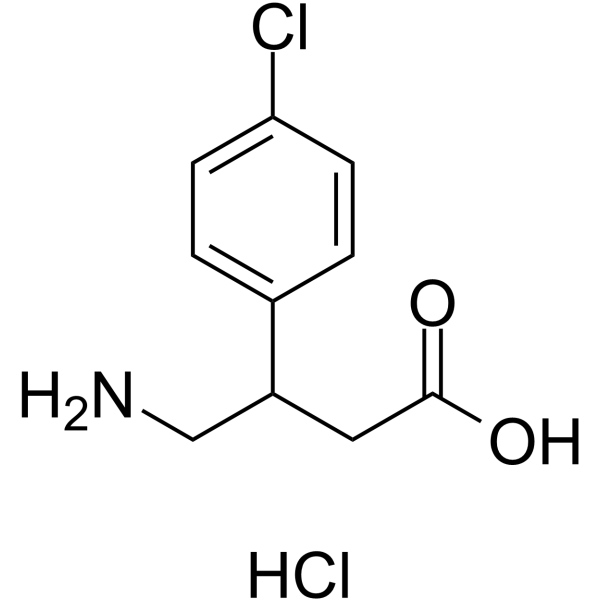Baclofen hydrochloride
Modify Date: 2024-01-05 19:06:20

Baclofen hydrochloride structure
|
Common Name | Baclofen hydrochloride | ||
|---|---|---|---|---|
| CAS Number | 28311-31-1 | Molecular Weight | 250.12 | |
| Density | N/A | Boiling Point | N/A | |
| Molecular Formula | C10H13Cl2NO2 | Melting Point | N/A | |
| MSDS | N/A | Flash Point | N/A | |
Use of Baclofen hydrochlorideBaclofen hydrochloride, a lipophilic derivative of γ-aminobutyric acid (GABA), is an orally active, selective metabotropic GABAB receptor (GABABR) agonist. Baclofen hydrochloride mimics the action of GABA and produces slow presynaptic inhibition through the GABAB receptor. Baclofen hydrochloride has high blood brain barrier penetrance. Baclofen hydrochloride has the potential for muscle spasticity research[1][2][3]. |
| Name | Baclofen hydrochloride |
|---|
| Description | Baclofen hydrochloride, a lipophilic derivative of γ-aminobutyric acid (GABA), is an orally active, selective metabotropic GABAB receptor (GABABR) agonist. Baclofen hydrochloride mimics the action of GABA and produces slow presynaptic inhibition through the GABAB receptor. Baclofen hydrochloride has high blood brain barrier penetrance. Baclofen hydrochloride has the potential for muscle spasticity research[1][2][3]. |
|---|---|
| Related Catalog | |
| In Vitro | Baclofen (1, 10 μM; 24 h) hydrochloride causes markedly decreased lactate dehydrogenase (LDH) activity, indicating increased cell viability in wild-type or mutant huntingtin-expressing striatal cells (HD19 or HD43). Baclofen significantly increases chymotrypsin-like proteasome activity and cell viability were in the HD43 cells[3]. |
| In Vivo | Baclofen (i.p.; 10 μg/g; twice daily for 3 consecutive days) hydrochloride ameliorates motor deficits in YAC128 HD transgenic mice[3]. Animal Model: Wild type (WT) and mutant (MT) male YAC128 mice at 13-18 months of age[3] Dosage: 10 μg/g Administration: IP; twice daily at 9:00 a.m. and 5:00 p.m., for 3 consecutive days; then single dose on the fourth day at 9:00 a.m Result: Ameliorated motor deficits in YAC128 HD transgenic mice. Increased proteasome activity and reduces neuronal intranuclear inclusions (NIIs) in YAC128 HD transgenic mice. |
| References |
| Molecular Formula | C10H13Cl2NO2 |
|---|---|
| Molecular Weight | 250.12 |